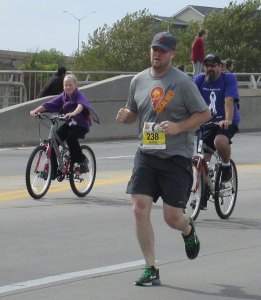Anyone who has ever completed a running race remembers the rush they felt when they first crossed the finish line. There is an immediate sense of accomplishment and fulfillment that comes when one runs through the finishers’ chute. Often the first though may be “That was fun!” or “That was really hard!” Frequently, the next thoughts are, “When can I do it again?” and “I bet I can run it faster the next time!” Part of the fun of running is setting and achieving new goals. Whether you are a beginning runner looking to improve running speed and economy or you are a veteran racer, following Project Purple’s Coach Jane’s advice can help you to become a faster and stronger runner.
Before striving to run long or fast, all runners should make sure that they have a solid aerobic base. Coach Jane suggests that beginners run three miles continuously three times per week before trying to add in more advanced running techniques. The body needs time to adapt to the stress of running, so it is crucial to allow your muscles and bones time to adapt to new training loads.
Runners generally seek to improve in two areas: speed and endurance. If you are wanting to move up from the 5k distance to the 10k distance, or from half-marathon to marathon, then improving endurance is key. Coach Jane recommends doing one long run per week, adding on one mile to the run each week until the goal distance is reached. For the half-marathon distance, the long run goal may be 9 to 11 miles. For the marathon, most runners will want to complete 20 miles prior to race day.
While getting the long run in is important, recovery is a critical component of any training plan. Coach Jane says, “Make sure to take a “down” week every 6 to 8 weeks, where you scale back your total weekly mileage by around 50%. Also, take at least one extra full rest day. These weeks are key to keeping you fresh, healthy and motivated!”
Once you are able to run your goal long run mileage, Jane suggests building up the length of your other weekly runs until you are able to complete 5 or 6 miles twice per week in addition to your long run. When you are able to complete this mileage comfortably, then you can begin to think about increasing the frequency of your runs. Jane adds, “You will be surprised at how strong and fit you can get off of easy runs alone with a simple progressive increase in mileage. Remember that whether you are increasing your long run, your weekly runs or your frequency of runs, do not jump up in total mileage by more than 10% per week!”
If you are working towards improving speed at this juncture, Coach Jane has a few recommendations. For beginning runners, the best way to introduce speed work is to incorporate fartlek runs. Fartlek is a Swedish word that means “speed play”. Fartleks incorporate faster sections of running with slower jogs in between. A sample fartlek workout would start with an easy 5 minute warm-up jog followed by running one minute hard with a two-minute easy recovery jog. Jane recommends repeating the one minute hard/two minutes easy cycle five times. Finish this workout with an easy five-minute cool-down jog. Jane says, “I would do fartlek runs no more than once per week. Each week increase either the number of fast repeats or the length of the interval, but do not increase both at the same time.”
More advanced runners can incorporate interval workouts into their training. Most interval workouts take place on the track, where runners can accurately track their time over a measured distance. “These tend to be a more intense type of workout, since time is the variable and the harder you push yourself, the faster you complete the section,” Jane explains. She adds, “Start with one interval and increase by one each week. For rest periods, a good rule of thumb is to rest for half as much time as it takes you to complete the interval. So, if running a 400 meter takes you two minutes, then rest for one minute before tackling the next repeat.”
Finally, runners can add in hill training to help improve strength and speed. Hill training is often referred to as “speed work in disguise.” Jane explains, “While you may not be running as fast up a hill as you would around a track, you are using more force per stride, leading to increased muscle strength. Doing long hill repeats works your slow-twitch muscle fibers and contributes to improved cardiovascular endurance. They are the most beneficial workout for runners training for endurance races like the half-marathon and marathon. Shorter, steeper hill repeats of less than 100 meters preferentially work your fast-twitch muscle fibers and develop your power and speed.”
Jane recommends starting with one or two long hill repeats of 400 meters or longer, building up to hill 8 to 10 repeats total. Recover between repeats by jogging slowly and in control back down the hill. Hill workouts should be done once per week.
Recovery is essential to any training program. Proper recovery helps lead to improvements in endurance and/or speed Jane recommends taking at least one full rest day per training week. Jane explains, “Rest days are just as important as training days, as they allow your body to recover from the training you have put in, and are rest for the training to come. My former track coach used to say, ‘you get faster when you rest.’ This may sound counterintuitive, but makes sense once you think about it. If you trained hard every day, you would simply be continuously breaking down muscle. It is the cycle of break down and then repair that ultimately builds strength, speed and endurance, and leads to improved performance.”
By following these principles of slowly and gradually building in long runs, speed workouts and hill workouts, and by incorporating plenty of rest and recovery time, any runner can work towards achieving new time or distance goals. Sign up to run with Project Purple today. Make your miles matter and get expert advice from our own Coach Jane!






